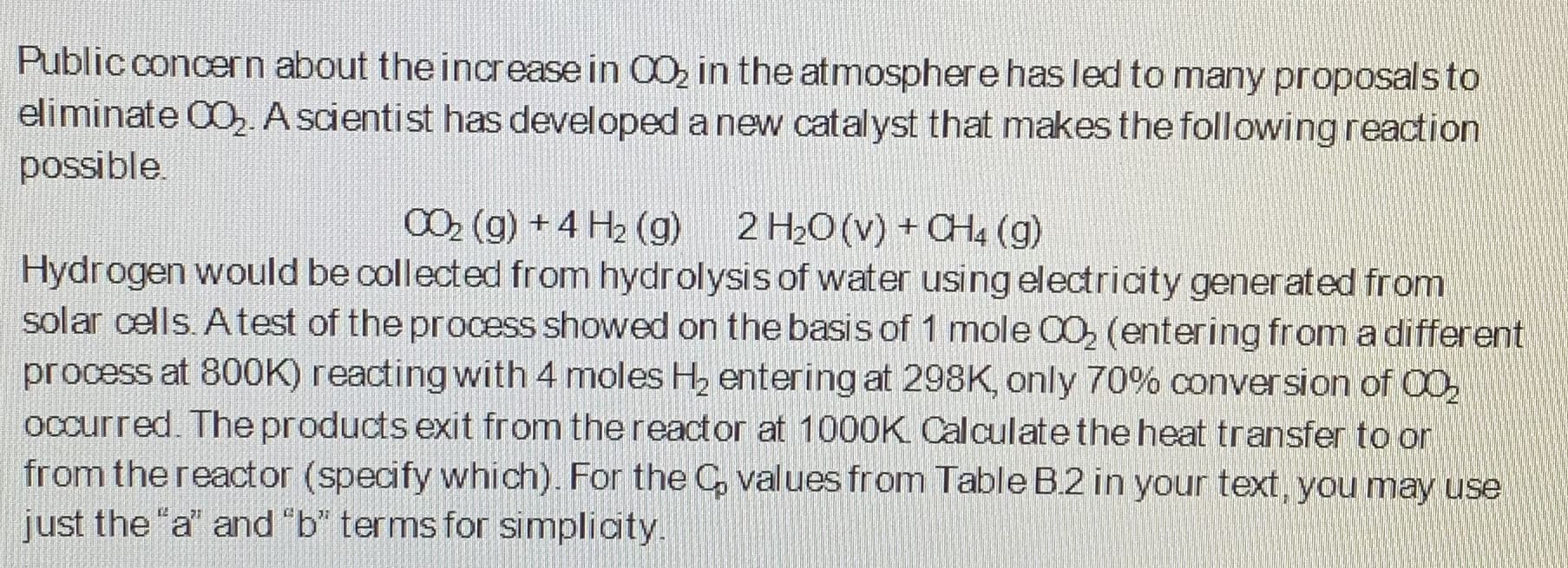Public concern about the increase in C0, in the atmosphere has led to many proposals to eliminate 0 A scientist has developed a new catalyst that makes the following reaction possible 0O2 (g) +4 H2 (g) 2 H20(v) +CH4 (g) Hydrogen would be collected from hydrolysis of water using electricity generated from solar cells. A test of the process showed on the basis of 1 mole OO2 (entering from a different process at 800K) reacting with 4 moles H2 entering at 298K, only 70% conversion of (0 occurred. The products exit from the reactor at 1000K. Calculate the heat transfer to orn from the reactor (specify which For the values from Table B.2 in your text, you may u just the"a" and "b"terms for simplicity
Public concern about the increase in C0, in the atmosphere has led to many proposals to eliminate 0 A scientist has developed a new catalyst that makes the following reaction possible 0O2 (g) +4 H2 (g) 2 H20(v) +CH4 (g) Hydrogen would be collected from hydrolysis of water using electricity generated from solar cells. A test of the process showed on the basis of 1 mole OO2 (entering from a different process at 800K) reacting with 4 moles H2 entering at 298K, only 70% conversion of (0 occurred. The products exit from the reactor at 1000K. Calculate the heat transfer to orn from the reactor (specify which For the values from Table B.2 in your text, you may u just the"a" and "b"terms for simplicity
Introduction to Chemical Engineering Thermodynamics
8th Edition
ISBN:9781259696527
Author:J.M. Smith Termodinamica en ingenieria quimica, Hendrick C Van Ness, Michael Abbott, Mark Swihart
Publisher:J.M. Smith Termodinamica en ingenieria quimica, Hendrick C Van Ness, Michael Abbott, Mark Swihart
Chapter1: Introduction
Section: Chapter Questions
Problem 1.1P
Related questions
Question

Transcribed Image Text:Public concern about the increase in C0, in the atmosphere has led to many proposals to
eliminate 0 A scientist has developed a new catalyst that makes the following reaction
possible
0O2 (g) +4 H2 (g) 2 H20(v) +CH4 (g)
Hydrogen would be collected from hydrolysis of water using electricity generated from
solar cells. A test of the process showed on the basis of 1 mole OO2 (entering from a different
process at 800K) reacting with 4 moles H2 entering at 298K, only 70% conversion of (0
occurred. The products exit from the reactor at 1000K. Calculate the heat transfer to orn
from the reactor (specify which For the values from Table B.2 in your text, you may u
just the"a" and "b"terms for simplicity
Expert Solution
This question has been solved!
Explore an expertly crafted, step-by-step solution for a thorough understanding of key concepts.
This is a popular solution!
Trending now
This is a popular solution!
Step by step
Solved in 6 steps with 4 images

Recommended textbooks for you

Introduction to Chemical Engineering Thermodynami…
Chemical Engineering
ISBN:
9781259696527
Author:
J.M. Smith Termodinamica en ingenieria quimica, Hendrick C Van Ness, Michael Abbott, Mark Swihart
Publisher:
McGraw-Hill Education

Elementary Principles of Chemical Processes, Bind…
Chemical Engineering
ISBN:
9781118431221
Author:
Richard M. Felder, Ronald W. Rousseau, Lisa G. Bullard
Publisher:
WILEY

Elements of Chemical Reaction Engineering (5th Ed…
Chemical Engineering
ISBN:
9780133887518
Author:
H. Scott Fogler
Publisher:
Prentice Hall

Introduction to Chemical Engineering Thermodynami…
Chemical Engineering
ISBN:
9781259696527
Author:
J.M. Smith Termodinamica en ingenieria quimica, Hendrick C Van Ness, Michael Abbott, Mark Swihart
Publisher:
McGraw-Hill Education

Elementary Principles of Chemical Processes, Bind…
Chemical Engineering
ISBN:
9781118431221
Author:
Richard M. Felder, Ronald W. Rousseau, Lisa G. Bullard
Publisher:
WILEY

Elements of Chemical Reaction Engineering (5th Ed…
Chemical Engineering
ISBN:
9780133887518
Author:
H. Scott Fogler
Publisher:
Prentice Hall


Industrial Plastics: Theory and Applications
Chemical Engineering
ISBN:
9781285061238
Author:
Lokensgard, Erik
Publisher:
Delmar Cengage Learning

Unit Operations of Chemical Engineering
Chemical Engineering
ISBN:
9780072848236
Author:
Warren McCabe, Julian C. Smith, Peter Harriott
Publisher:
McGraw-Hill Companies, The